SSD technology literacy: What is NVMe? What are the characteristics of NVMe SSDs?
Release time:2024-06-04 Number of views:2848Students who install and configure SSDs themselves should be aware that in order for SSDs to truly perform, they need to switch the SATA controller mode to AHCI in the BIOS. Using AHCI mode is indeed the correct choice for SATA devices, and switching to AHCI can achieve better performance. But now the new storage interfaces M.2 and SATA-E both use the PCI-E channel, so AHCI is not a good choice for PCI-E. To achieve optimal performance, a new standard - NVMe is actually needed.
What is NVMe?
NVMe (Non Volatile Memory express) is a standard (or protocol) built on the M.2 interface, specifically designed for flash memory storage. Note that it is not an interface.
Similar standards (or protocols) include AHCI, etc.
NVMe SSD products
Samsung 960 EVO 250G M.2 NVMe Solid State Drive
The Intel 600P series 128G M.2 2280 interface solid-state drives and other products use the NVMe standard. When purchasing SSD hard drives, the manufacturer usually indicates in the specifications:
For example, the product introduction of a certain Dongshang

Products that were originally only applied to enterprise level products have now entered the consumer market, driven by Intel and Samsung. As the battlefield of high-end SSDs has shifted to PCI-E and M.2 interfaces, the outdated AHCI standard is no longer appropriate. More and more host manufacturers are launching NVMe supported hosts, and in the future, more SSDs that support NVMe standards will be introduced to the market. So what is NVMe?
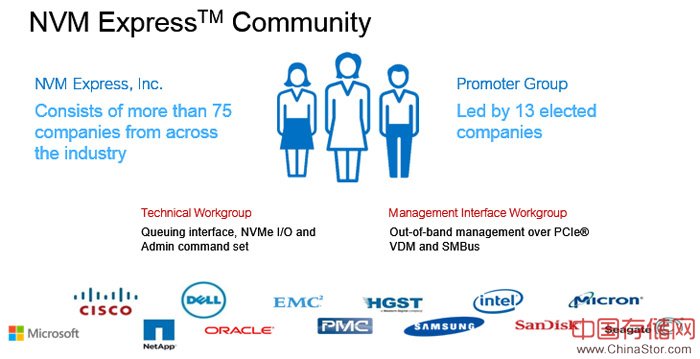
If we talk about AHCI, everyone should understand more. NVMe, like AHCI, is actually a logical device interface standard (it is an interface standard, not an interface! Not an interface! Not an interface! Because it is very important, it is said three times). NVMe, also known as Non Volatile Memory Express, is a specification for SSDs that use the PCI-E channel. NVMe was designed to fully utilize the low latency and parallelism of PCI-E SSDs, as well as the parallelism of contemporary processors, platforms, and applications. The parallelism of SSDs can be fully utilized by the host's hardware and software, and compared to the current AHCI standard, the NVMe standard can bring multiple performance improvements.
The Origin of NVMe Standard (also known as Protocol)
The SATA interface and AHCI standard currently used are actually designed for high latency mechanical hard drives. Currently, mainstream SSDs still use them, and early SSDs may not have felt any problems when their performance was not high. However, as SSD performance gradually improves, these standards have become a major bottleneck limiting SSDs. The AHCI standard designed specifically for mechanical hard drives is not very suitable for low latency SSDs.
Of course, the industry has long recognized this issue. In the second half of 2009, technical work on NVMe was officially launched, and the NVMe specification was customized by a working group consisting of more than 90 companies. Intel was the main leader, and the group members included companies such as Micron, Dell, Samsung, Marvell, NetAPP, EMC, IDT, etc. The purpose was to establish a new storage specification standard for SSDs, freeing them from the old SATA and AHCI.
In 2011, the NVMe standard was officially released, which was customized based on the characteristics of flash storage. The new standard lifted various restrictions imposed by the old standard on SSDs. The standard was upgraded to NVMe 1.1 in 2012, and the new NVMe 1.2 standard was launched in 2014.
The first product to support NVMe standards was the Samsung XS1715, which was released in July 2013. Subsequently, enterprise level NVMe standard SSDs were introduced, and it was not until the release of Intel 750 this year that NVMe standard products began to enter the consumer market.
The advantages of NVMe SSDs
Advantage 1 of NVMe SSD: Low latency
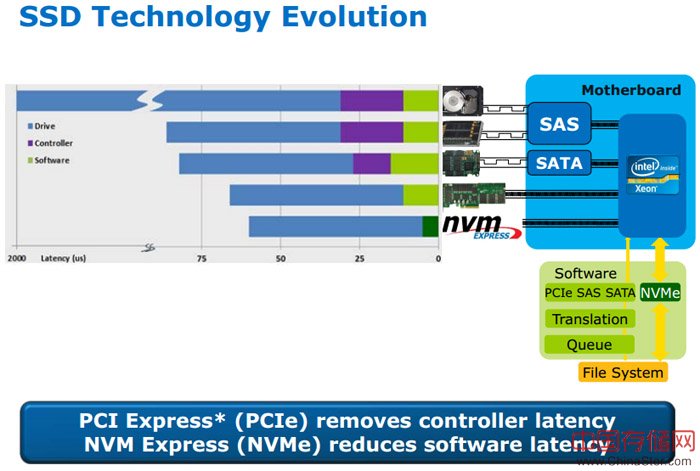
When it comes to the advantages of NVMe standard over AHCI standard, one of them is low latency. As can be seen from the above figure, NVMe standard is designed for PCI-E SSDs. By using native PCI-E channels and directly connecting to the CPU, it can eliminate the delay caused by communication between external controllers (PCH) with SATA and SAS interfaces and the CPU.
In terms of software layer, NVMe's standard latency is less than half that of AHCI, and NVMe simplifies the call method, eliminating the need to read registers when executing commands; Each AHCI command requires reading registers 4 times, consuming a total of 8000 CPU cycles, resulting in a delay of approximately 2.5 microseconds.

Lower latency can skyrocket the 4KB QD1 transmission capacity of SSDs
Advantage 2 of NVMe SSD: Significant increase in IOPS
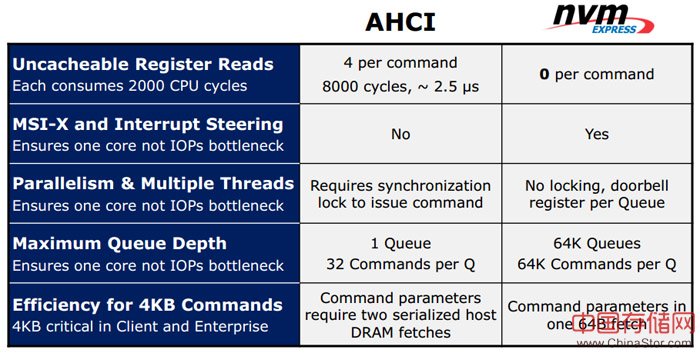
In addition, NVMe has greatly improved the IOPS performance of SSDs. The idea of parallelism was not fully integrated into the AHCI specification. The use of NCQ functionality can optimize transmission capacity, but the interface does not allow SSDs to truly maximize their parallelism.
Nowadays, SSD testing usually only tests IOPS capabilities with a queue depth of 32. In fact, the ultimate reason is that this is the upper limit of AHCI. In fact, many flash memory controllers can provide better queue depth. NVMe can increase the queue depth from 32 to 64000, and the IOPS capability of SSDs will also be significantly improved.

NVMe also supports receiving commands and prioritizing requests from multi-core processors at the same time, which is advantageous in enterprise level heavy loads.
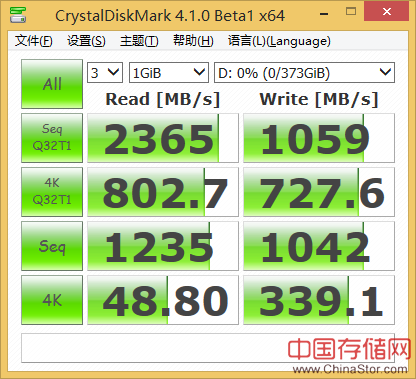
The advantage of low latency and good parallelism is that it can significantly improve the random performance of SSDs. The Intel 750 we tested is an NVMe SSD, and its random performance is absolutely top-notch, capable of delivering excellent speed at any queue depth.
Advantage Three of NVMe SSDs: Lower Power Consumption

NVMe has added automatic power state switching and dynamic energy management functions. Devices can switch from Power State 0 to Power State 1 after being idle for 50ms. If they continue to be idle, they will enter Power State 2 with lower power consumption after 500ms, and there will be a brief delay during switching. SSDs can be quickly controlled at extremely low levels when idle, and NVMe standard SSDs have significant advantages in power management compared to mainstream AHCI SSDs. This is particularly important for mobile devices, as it can significantly increase the battery life of laptops and tablets.
Advantage 4 of NVMe SSD: Wide applicability of drivers
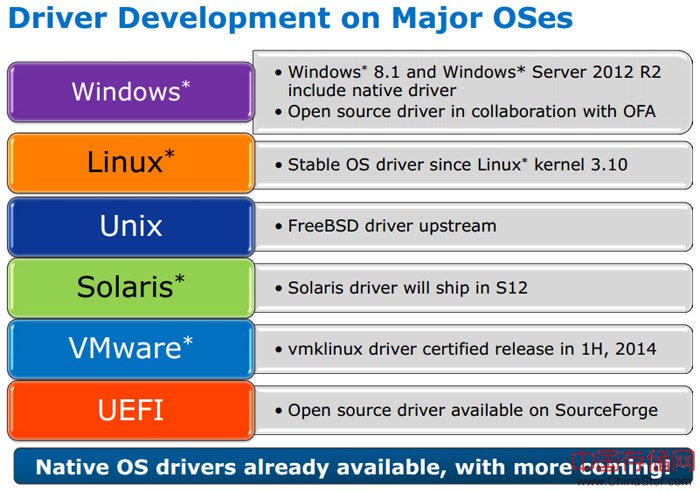
The compatibility of drivers is also a common issue for all PCI-E SSDs, as each product has dedicated drivers for different systems. Some manufacturers excel in this aspect, while others are not. However, many PCI-E SSDs require drivers to be loaded in order to boot properly.
The emergence of the NVMe standard has solved this problem. NVMe SSDs can be easily matched to different platforms and systems without the need for manufacturers to provide corresponding drivers to work properly. Currently, support for NVMe SSDs has been added to Windows, Linux, Solaris, Unix, VMware, UEFI, and other platforms. Of course, Intel's products have their own drivers. Without installing Intel drivers, SSDs can function normally, but performance cannot be fully utilized. This issue was encountered during testing of Intel 750 before, and other manufacturers are not sure how it works.
Contact us
Office address: Room 606, Tongfang chuangxiang commune, XINER Sports Center complex building, Xinqiao street, Bao'an District, Shenzhen
Hotline: 0755-27502764
National/enterprise level:135-1068-5504
188-9877-7001
Industry/Work Regulations:135-3095-1400
189-2939-2673
Mailbox:sales@pancunstorage.com
